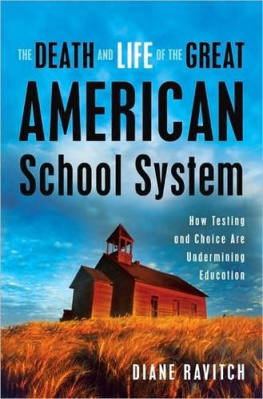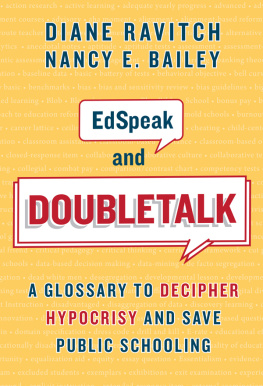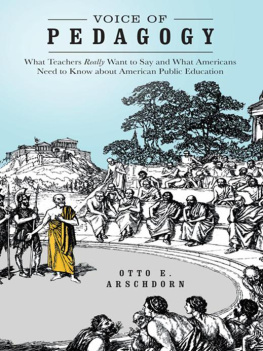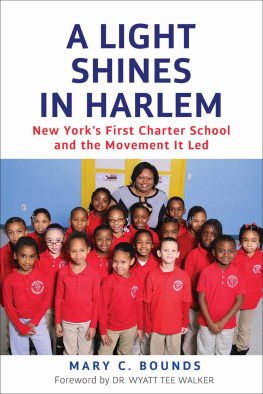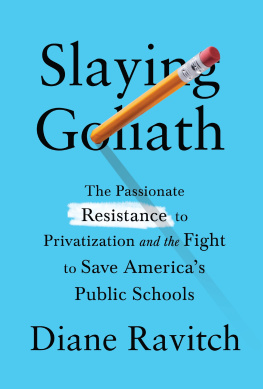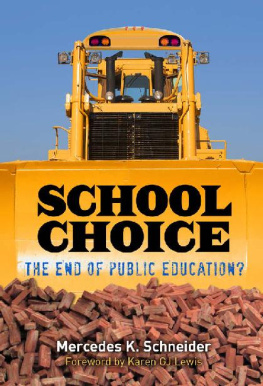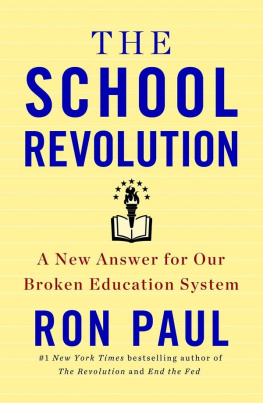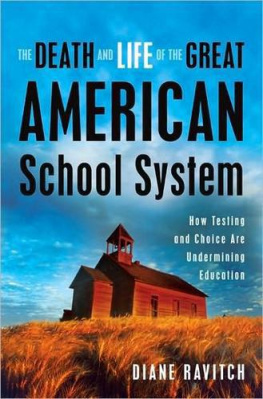THIS IS A BORZOI BOOK
PUBLISHED BY ALFRED A. KNOPF
Copyright 2013 by Diane Ravitch
All rights reserved. Published in the United States by Alfred A. Knopf, a division of Random House LLC, New York, a Penguin Random House company, in Canada by Random House of Canada Limited, Toronto.
www.aaknopf.com
Knopf, Borzoi Books, and the colophon are registered trademarks of Random House LLC.
Grateful acknowledgment is made to Alfred Publishing Co., Inc. for permission to reprint an excerpt from Plant a Radish, lyrics by Harvey Schmidt, music by Tom Jones. Copyright 1960, 1963 (renewed) by Tom Jones and Harvey Schmidt. Publication and allied rights assigned to Chappell & Co. All rights reserved. Reprinted by permission of Alfred Publishing Co., Inc.
eBook ISBN: 978-0-385-35089-1
Hardcover ISBN: 978-0-385-35088-4
Library of Congress Cataloging-in-Publication Data
Ravitch, Diane.
Reign of error : the hoax of the privatization movement and the danger to Americas public schools / Diane Ravitch.
pages cm
ISBN 978-0-385-35088-4
1. Privatization in educationUnited States. 2. School choiceUnited States. 3. Education and stateUnited States. I. Title.
LB 2806.36.r38 2013
379.3dc23
2013015275
Cover design by Jason Booher
v.3.1_r1
This book is dedicated with love >
democracy. All that society has accomplished for itself is put, through the agency of the school, at the disposal of its future members. All its better thoughts of itself it hopes to realize through the new possibilities [are] thus opened to its future self.
J OHN D EWEY , 1907
The whole people must take upon themselves the education of the whole people and be willing to bear the expenses of it. There should not be a district of one mile square, without a school in it, not founded by a charitable individual, but maintained at the public expense of the people themselves.
J OHN A DAMS
/div>
Contents
<
Introduction
The purpose of this book is to answer four questions.
First, is American education in crisis?
Second, is American education failing and declining?
Third, what is the evidence for the reforms now being promoted by the federal government and adopted in many states?
Fourth, what should we do to improve our schools and the lives of children?
In this book, I show that the schools are in crisis because of persistent, orchestrated attacks on them and their principals, and attacks on the very principle of public responsibility for public education. These attacks create a false sense of crisis and serve the interests of those who want to privatize the public schools.
My last book sought to show that many of the policies promoted by the Bush administration, the Obama administration, and the nations largest foundations had meager evidence to support them, and in some cases no evidence at all, and were likely to harm public education without improving the schools. In this book, I report additional evidence about the failure of the Bush-Obama reforms.
In the spring of 2011, I decided to write this book as a result of a conversation with said to me, Your critics say you are long on criticism but short on answers.
I said, You have heard me lecture, and you know that is not true.
He suggested that I write a book to respond to the critics.
So I did, and this is that book.
I do not contend that the schools are fine just as they are. They are not. American education needs higher freedom from burdensome and intrusive regulations that undermine professional autonomy. They need the resources to meet the needs of the children they enroll. But they cannot improve if they are judged by flawed measures and continually at risk of closing because they do not meet an artificial goal created and imposed by legislators.
Schools need stability, adequate resources, well-prepared and experienced educators, community support, and a clear vision of what good education is. The
CHAPTER 1
Our Schools Are at Risk
I n the early years of the twenty-first century, a bipartisan consensus arose about educational policy in the United States. Right and left, national security, our very survival as a nation. This crisis is so profound that half measures and tweaks will not suffice. Schools must be closed and large numbers of teachers fired. Anyone who doubts this is unaware of the dimensions of the crisis or has a vested interest in defending the status quo.
Furthermore, according to this logic, now widely shared among policy makers and opinion shapers, blame must fall on the shoulders of teachers and principals. Where test scores are low, it is their fault. They should be held accountable for thisdisability status value educational catastrophe. They are responsible because they have become comfortable with the status quo of low expectations and low achievement, more interested in their pensions than in the children they teach.
In response to this crisis, the reformers have a ready path for solving it. Since teachers are the problem, their job protections must be eliminated and teachers must be fired. Teachers unions must be opposed at every turn. The hoops and hurdles that limit entry into teaching must be eliminated. Teachers must be evaluated on the basis of their students test scores. Public schools must be evaluated on an objective basis, and when they are failing, they must be closed. Students must be given online schools.
television documentaries, the battle lines are clearly drawn. Traditional public schools are bad; their supporters are apologists for the unions. Those who advocate for charter schools, virtual schooling, and school choice are reformers; their supporters insist they are championing the rights of minorities. They say they are leaders of the civil rights movement of our day.
It is a compelling narrative, one that gives us easy villains and ready-made solutions. It appeals to values Americans have traditionally cherishedchoice, freedom, optimism, and a latent distrust of government.
There is only one problem with this narrative.
It is wrong.
Public education is not broken. It is not failing or declining. The diagnosis is wrong, and the solutions of the corporate reformers are wrong. Our urban schools are in trouble because of concentrated test scores. At the same time, the reformers solutions have had a destructive impact on education as a whole.
Far from being progressive, these changes strike at the heart of one of our nations most valued institutions. Liberals, progressives, well-meaning people have lent their support to a project that is antithetical to liberalism and progressivism. By supporting market-based reforms, they have allied themselves with those who seek to destroy public education. They are being used by those who have an implacable hostility toward the public sector. The transfer of public funds to private management and the creation of thousands of deregulated, unsupervised, and unaccountable schools have opened the public coffers to profiteering, fraud, and exploitation by large and operating under contract to the teachers8F small entrepreneurs.
As a historian of American education, I have seen, studied, and written about waves of school reforms that came and went. But what is happening now is an astonishing development. It is not meant to reform public education but is a deliberate effort to replace public education with a privately managed, free-market system of schooling. Public education, established in Americas towns and villages in the freedom, we may lose one of our societys greatest resources, our public school systema system whose doors are open to all.


